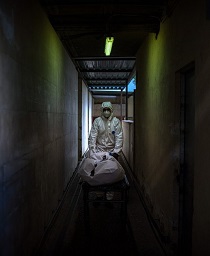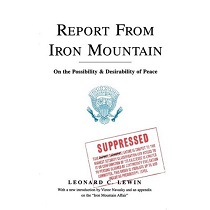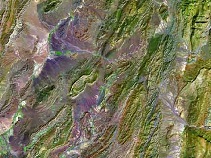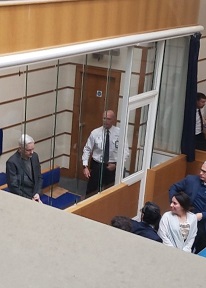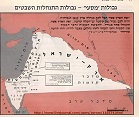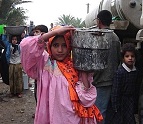Israel is Stealing Palestinian and Arab Water
Sawsan Ramahi
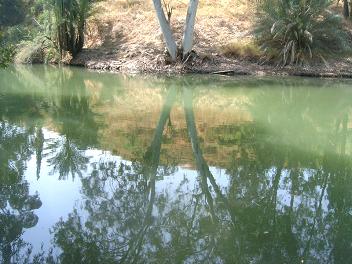
The Jordan River near the Sea of Galilee in Israel.
[Download report] World Water Day is upon us. Initiated by the United Nations in 1992 during its Conference on Environment and Development, 22 March 1993 was chosen as the first international day for water aiming to draw attention to the importance of fresh water and its availability. The commemoration of the day has since focused every year on a different aspect of the difficulties faced by people in obtaining fresh water.
There is no doubt that UN interest in this matter is of great importance, although the world body needs to do more than merely have an annual day on the issue. What is required is for the UN to put an end to the monopoly of water by any state which has water sources within its borders and to put an end to the diversion and theft of water from occupied lands.
When an occupying power exploits the resources of the occupied land at the expense of the original inhabitants, it builds itself on the ruins of what it has destroyed, and such theft of resources is obvious, even when the occupier tries to hide its actions behind noble principles. This malfeasance is made worse by claiming that the land in question is a gift from God and politically-motivated myths such as it is "a land without a people for a people without land". When such wrongdoing is compounded even further by acts of genocide against the indigenous people, killing thousands and dispossessing hundreds of thousands in acts of ethnic cleansing, the situation is very serious indeed. Following on from the efforts to destroy the necessities of life for those under occupation, the occupier has sought to control the main necessity, the water resources. The de facto annexation and control of water in the occupied Palestinian territories has always been, alongside the colonisation of land, one of Israel’s priorities.
This long-standing aim of the Jewish state has been confirmed by confidential documents published by the British Foreign Office, in which David Ben-Gurion, writing in 1941, said, "We have to remember that for the Jewish state's ability to survive it must have within its borders, the waters of the [rivers] Jordan and Litani".
Israel's control of Arab water
Since 1948 the Israeli authorities have sought to control the majority of the water resources in Palestine. After the 1967 war Israel gained control of the main Arab water sources in the Middle East,
1. The upper Jordan River basin, which originates from Lebanon and Syria:Israel Seized the Jordan River and stored its water in Lake Tiberius (the Sea of Galilee), then transported the water from north to south to feed the different areas of Israel. Israel gets 60% of this water, while Jordan gets 25% and Syria 15%, despite its source being within Syria’s borders. It has also prevented the Palestinians from reaching the Jordan River, destroyed all their pumps on the river and evicted the farmers.
2. As a result of the diversion of water from the river by Israel the land on both banks has been affected, while the salt level in the water has increased considerably.
3. Yarmouk River basin shared between Jordan and Syria:
When Israel occupied the Golan Heights, it prevented Syria from benefiting from its water; today 30% of Israel's water comes from the Golan Heights. It also captured the Syrian water source in the Yarmouk River Basin. The Golan Heights is the main source of water flowing to the Jordan River and Lake Tiberius, which provide water to Syria, Jordan and Palestine; this is why Israel refuses to give up these water sources in any negotiations with Syria.
4. Large underground reservoirs in the West Bank, known as the Reservoir of the Mountain and the Mountain-Well; the Palestinians have been unable to have access to them since 1967.
● When Israel invaded Lebanon in 1978 it controlled nearly 30% of the Litani River, and during the occupation of Lebanon in 1982 the Israelis benefited from the Wazzani and the Litani’s waters, transferring water from them to Israel, while expelling the Lebanese farmers dependent on them.
● In 1989 the Israelis took advantage of the Hasbani and Wazzani waters by installing pipes for themselves, and despite withdrawing from Lebanon in 2000 there are still many Israeli artesian wells on the borders which reduce the groundwater in Lebanese territory.
● Israel uses various means to control the waters of the River Nile, which is 6825 km long and has two main sources; the Equatorial Lakes Region of Southern Sudan and the Ethiopian plateau. Israel tries from time to time to cooperate with Ethiopia to build dams and other facilities to control the Nile waters, seeking to reduce Egypt’s share of water and put pressure on it in order to secure its share of Nile water. This much has been disclosed by senior officials.
Control over the waters of the West Bank and Gaza and the water crisis threaten their populations
Since Israel began its occupation of the West Bank and Gaza Strip it has striven to remain in control of the water resources and diverted water from the Palestinian territories to the cities and settlements set up on the ruins of Palestinian towns destroyed in 1948.
Abdel-Rahman Tamimi, a water expert, says that the water battle with the occupation started early on, with military orders and systematic control of water basins, wells and springs since the occupation of the West Bank started in 1967. According to Mr. Tamimi, the water sources were placed under the control of the Israeli Civil Administration in the 1970s, and even after the Oslo agreement they remained under Israeli control, "which exacerbated the water problem in the West Bank."
The Gaza Strip depends on the coastal underground water reservoir that lies under the Mediterranean Sea between Rafah in the south and north of Mount Carmel, a total area of 2200 km2, of which 400 km2 is located underneath the Gaza Strip. This groundwater is largely independent of the groundwater inside Israel because of the flow of water in an east-west direction into the reservoir; thus, the amount of water available to Palestinians in the Gaza Strip would be reasonable had Israel not confiscated more than 80% of the Palestinian groundwater to make up 20% of the Israelis’ total water consumption which stands at 2 billion cubic metres per annum. Due to this, it is estimated that this underground fresh water source will run dry within the next 8 years.
The Palestinian Water Authority has explained that the Gaza Strip is suffering from an annual water deficit of up 70 million cubic metres, noting that as a result of natural population growth in the Strip there are now more than a million and a half people depending on a single source of water, the coastal aquifer, to meet their needs. The authority also noted the negative effect on the quality of groundwater due to sea water intrusion, causing high salinity and adding to the high concentration of nitrates in the water, caused by the leakage of sewage and the return underground of irrigation water.
The authority’s report states that 90-95% of groundwater used for domestic purposes is not fit for human consumption and not compliant with the World Health Organization standards for drinking water, in terms of quality and quantity, which constitutes a serious threat to health and is a cause of many diseases affecting the population of the Gaza Strip.
The Water Authority says that the rate of water available per person per day is about 80 litres, equivalent to half the recommendation of the World Health Organization.
The West Bank depends on artesian wells for drinking and agricultural purposes. The capacity of running water and water springs in the West Bank ranges, according to the estimates of many experts, between 30 and 50 million cubic metres annually. The springs in the West Bank are estimated to have a capacity of about 75-115 million cubic metres. This was before the Israelis began to use 730 wells in the West Bank for different purposes. There are now 214 wells, of which only 20 are reserved for household purposes, functioning with a production capacity set by the Israeli authorities at about 37.9 million cubic metres annually. The remaining wells have dried up due to pumping from deep wells dug by the Israeli military authorities, or due to being abandoned.
The rate of water consumption of Israel citizens is 344 million cubic metres per year, while the consumption of Palestinians stands at 93 million cubic metres per year. The domestic consumption of Israelis amounts to 98 million cubic metres, while for Palestinians it comes to 56 million cubic metres per year. It is clear that the Israelis use and waste more water than anyone else in the region.
A study has been made of this issue by the Palestinian Institute for Economic Policy Research (MAS), prepared by Annan Jayyousi, a lecturer at the Faculty of Engineering in Al-Najah University and an expert on the subject of water, and Fathi Srougi, an expert on geopolitical issues relating to water.
Jayyousi referred to the volume of water resources in historic Palestine, which is estimated by Israelis hydrologists at about 2250 million cubic metres of renewable water, and includes 3 reserves within the West Bank area producing about 679 million cubic metres of water. According to international law, this water belongs to the Palestinians but they only get 118 million cubic metres. In other words, Palestinians get just 15% of their own water while the rest is consumed by Israelis.
Regarding the use of water for domestic purposes Jayussi said,
"The supply quantity is estimated at about 130 million cubic metres in the West Bank and Gaza Strip; this means that the average person's water supply is estimated at around 97 litres per day. That said however, the actual average consumption falls short of 70 litres per day, due to the high rate of wasted water."
This is due to overdue maintenance work on the pipe network, among other reasons. Jayussi estimates use by the industrial sector at a total of about 9 million cubic metres annually.
In the agricultural sector, the study shows that the average share of irrigated land for an individual is only 0.071 dunams (1000 m2). Furthermore the use of water for irrigation does not exceed 45 cubic metres per person, which is less than the prevailing rates in Jordan and Israel.
It must be noted that Israel has not allowed the Palestinians to control their water according to their needs, but tied them up in resolutions through which the Jewish state:
1. Limits the amount of water withdrawals to no more than 100 cubic metres per hour.
2. Limits the depth of drilled wells to 140 metres, requiring specific types of old pumps which are permitted in the West Bank, essentially limiting the capacity to extract water from these wells.
3. Dug huge wells in strategic areas where water accumulates across the West Bank and the Gaza Strip in order to steal Palestinian water (60 wells in the West Bank, 43 in the Gaza Strip, and 26 along the armistice line between Gaza and Israel.
4. Adopted a strategy of building small dams to prevent the natural flow of surface water to the Palestinian areas thus allowing the transfer of high quality water from Israeli settlements in the Palestinian territories into Israeli cities, or selling this water to the Palestinians.
5. Builds settlements such that they are in areas with the highest quality underground water reserves to allow Israel to seize the water, directly or indirectly, a policy which has lead to the depletion of groundwater in the Gaza Strip.
According to a study by the Palestinian Information Centre, 150 Palestinian residential communities in the West Bank are not part of the water distribution networks. Most residents in these communities suffer from water shortages.
Hebron as a model
The city of Hebron, in the south of the West Bank, is considered the most deprived Palestinian city in terms of lack of water, where the average Palestinian individual consumes as little as 10 litres of water per day for extended periods of time.
The water problem in Hebron is primarily a result of the Israeli occupation authority’s control over water basins; Palestinians are not permitted to dig wells and the Israelis do not provide the water necessary for daily use. An example illustrates the measures to which the Israelis are prepared to go with this: the Israeli army surprised four citizens from the village of Soba, west of Hebron as they were drilling a well to collect rainwater; they were surrounded and arrested, their equipment was confiscated; they were fined and finally released with strict orders not to resume drilling.
Abdel-Rahman Rajoub has commented on this:
"What is strange is that one of the detainees said that they had told the investigating officer, during the eight days that they were in custody, that the drilling was simply for the purpose of collecting rainwater. The officer accused them of ‘stealing groundwater’ and told them that rainwater collection is ‘forbidden’."
Pools of water destroyed in Hebron
To the east of Hebron, the Israeli army destroyed four large pools that collect water, and deprived large areas of agricultural land of irrigation water, causing great losses to dozens of farmers. Several said that this is in order
"to harass the Palestinians and force them into leaving the area, in order to clear it for settlement building."
The residents in this fertile region have resorted to making holes in water pipes to get the water needed to irrigate their crops, even though this is at the expense of their drinking water.
The impact of constructing the wall on water sources in the West Bank
In addition to the tactics noted above that are employed by the Israelis to seize Palestinian water, the occupation authority has used the illegal "separation wall" to ensure that it also has control of three of the most important Palestinian water basins, depriving the Palestinians of their right of access in order to send this water to settlements. As the construction of what is basically an apartheid wall continues in the West Bank, Palestinian official sources confirm that it will annex to Israel about 95% of the water that is accessible in the Western Basin, which is estimated at about 362 million metres.
The area isolated behind the western part of the wall lies above two basins; the western basin and north-east basin, which have an estimated annual capacity of 507 million cubic metres. The area isolated in the east lies completely over the eastern basin which has an estimated capacity of 172 million cubic metres annually. Water is extracted from these aquifers by pumping from wells or from the natural springs. The estimated number of groundwater wells in these regions is 165 with a pumping capacity of 33 million cubic metres per year; the number of springs is estimated to be 53, with a capacity of 22 million cubic metres per year.
In the Jenin, Qalqilya and Tulkarem provinces, the land annexed by the wall is entirely congruent with the locations of groundwater, meaning that all the groundwater reserves are on the wrong that is, the Israeli side of the wall. This renders as useless any Palestinian attempt to extract water from those reserves; as such, the wall threatens to drive to extinction irrigated agriculture in the north of the West Bank.
According to the report by the Palestinian Water Authority, the wall has led to the loss of Palestinian access to more than 36 wells, which includes 23 located directly on the route of the wall, and 13 others nearby that were used for agriculture and drinking; these wells now lie between the wall and the old "Green Line" (the 1967 armistice line). The wells used to pump about 55 million cubic metres per annum, around 25% of the total extracted from the Western reservoir. The occupation authorities are also seeking, through the route of the wall, to seize more than 400 m3 which constitutes the entire capacity of the renewable groundwater West Basin, of which most is accumulated within the borders of the Palestinian West Bank.
Contamination of groundwater reserves in the West Bank and Gaza Strip
Israel drains the Palestinian groundwater, which has led to an increase in the levels of salts, nitrates and chlorides, as well as heavy metal contaminations such as copper and lead, which deem it unsuitable for drinking or agricultural use. The draining of wells has also caused severe leakage of salty groundwater into fresh groundwater in the West Bank; in the Gaza Strip seawater has leaked into the groundwater basin to fill the vacuum.
The spread of diseases
The Palestinian Ministry of Health confirms the results of tests showing that the water in the networks is contaminated frequently, leading to the spread of diseases among the population. Analysis has shown a link between the contamination of water and the spread of diseases, such as typhoid fever, meningitis and cholera. An official in the Ministry of Health monitoring committee confirmed that they are examining all water continually, whether it is drinking water, for agriculture or for other uses. He said,
"There is an ongoing process of filtration and purification of the water in the wells which reduces the contamination and salt levels in the water."
The Israeli security forces hinder or prevent the implementation of many projects that have the potential to solve this problem, he added.
Conclusion
From the above we note that Israel is the cause of the water crisis for Palestinians in particular and for Arabs in general, a fact that the Jewish state refuses to acknowledge. Israel will continue with its plans to control more water resources, especially as it seeks to attract ever-greater numbers of Jewish immigrants.
Unfortunately, the Oslo agreement deferred negotiations of the issue of water to the anticipated ‘final status’ agreement, which was one mistake amongst many committed by the Palestinian negotiators. By agreeing to defer consideration of the most important issues until the ‘final status’ talks (including the status of Jerusalem, the return of refugees as well as the water issue), they have allowed Israel to introduce many changes and "facts on the ground" which the Palestinians will just have to accept.
The Jewish state avoids discussing the core issues such as the water problems of the Palestinians and tries to shift the focus to long-term solutions such as the search for alternative water sources, desalination plants and a reduction in the amount needed for agriculture.
It is worth remembering that unless proposals include Palestinian control over their own natural water resources, it is useless to talk about an independent Palestinian state, with real sovereignty over its air, land and sea. It is equally useless, to consider achieving genuine peace.
The United Nations should take its responsibilities seriously and oblige Israel to end its illegal occupation of Palestinian land, giving back to the Palestinians their inalienable rights, including control of its natural resources. As long as Israel is treated with kid gloves by the international community, as a state which is above the law, peace talks – proximity or direct – will continue to be diplomatic devices to give the Israelis more time to create more facts on the ground; and genuine peace and justice will remain as elusive as ever.
___________________________________________________________________________________
Source: http://www.middleeastmonitor.org.uk/resources/briefing-papers/805-israel-is-stealing-palestinian-and-arab-water?tmpl=component&print=1&layout=default&page=
Photo: http://www.magpro.org/index_2006-06-01.html
URL: http://www.a-w-i-p.com/index.php/2010/03/24/israel-is-stealing-palestinian-and-arab


